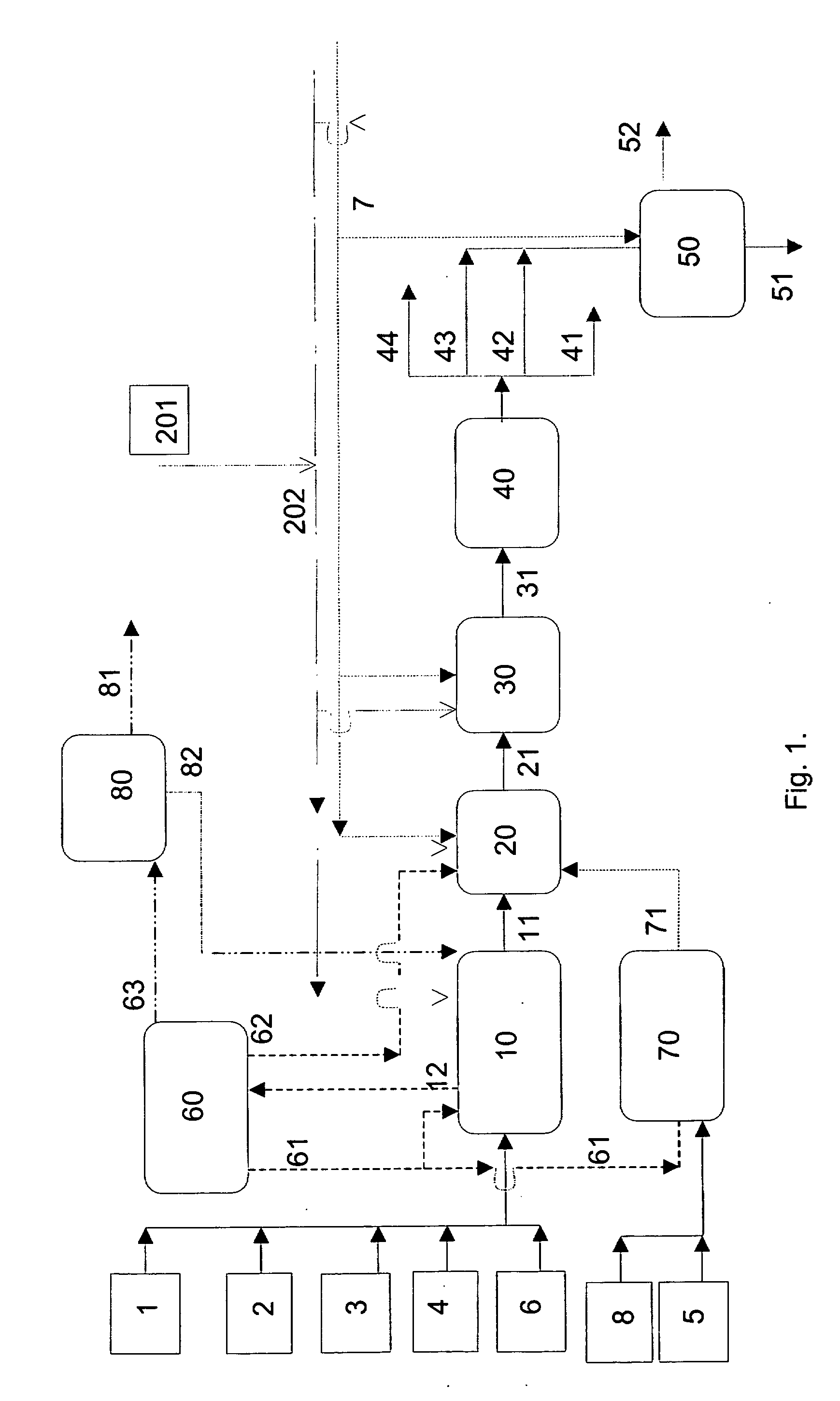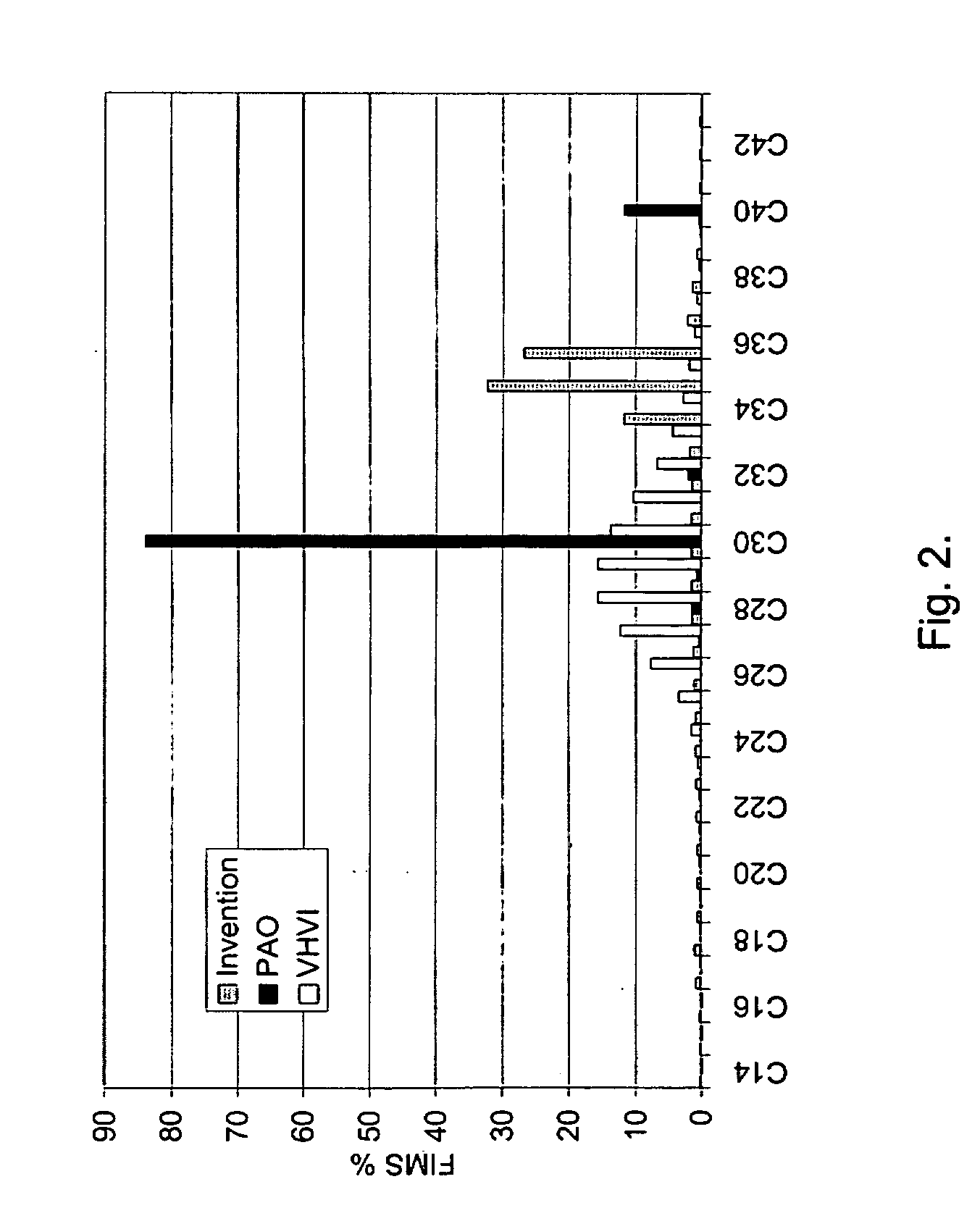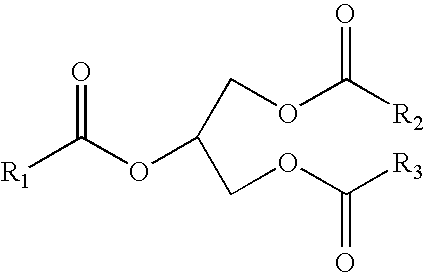Process for producing a saturated hydrocarbon component
a hydrocarbon component and hydrocarbon technology, applied in the field of hydrocarbon component production process based on oligomerization and deoxygenation, can solve the problems of small fraction of base oils manufactured today that are able to meet these demanding specifications, no longer being able to produce lubricants that meet these requirements, high volatility and modest viscosity index, etc., to achieve more stabilization, reduce carbon dioxide emissions, and increase the effect of atmospheric carbon dioxide load
- Summary
- Abstract
- Description
- Claims
- Application Information
AI Technical Summary
Benefits of technology
Problems solved by technology
Method used
Image
Examples
example 1
Preparation of a Hydrocarbon Component from Plant Oil
[0140] Feedstock containing 200 ml of soybean oil, 6 g of montmorillonite catalyst, and 5 ml of distilled water, was loaded in high pressure Parr reactor. The temperature was increased to 270° C. and the oil was allowed to oligomerize while slowly mixing for 7 hours.
[0141] Thereafter, in the HDO step, the mixture oligomerized above was hydrogenated in the high pressure Parr reactor using dried and activated NiMo / Al2O3 catalyst to yield i-paraffin. 200 ml of oligomerized soy oil mixture was hydrogenated at 325° C., under a hydrogen pressure of 5 MPa, until no acid groups were detected in the FTIR spectrum of the sample. The reaction mixture was mixed at 300 rpm. The final product was distilled, and mainly branched and cyclic C36 paraffin was obtained as the product.
[0142] The properties of the hydrocarbon component obtained are shown in Table 3. Hydrocarbon components may also be produced in a similar manner from other plant an...
example 2
Preparation of a Hydrocarbon Component from Methyl Esters of Carboxylic Acids Derived from Soybean Oil
[0143] Soybean oil was pretreated by transesterification with methanol under basic conditions, at temperature of 70° C. under a pressure of 0.1 MPa in the presence of a sodium methoxide catalyst in two steps. Methyl esters of carboxylic acids were purified by washing with an acid and water, and then they were dried. The carboxylic acid composition of the methyl ester derived from soybean oil was as follows: C16:0, 11%; C18:2, 20%; C18:1, 8%; C18:2, 54%; and C18:3, 6%.
[0144] The carboxylic acid methyl ester mixture obtained above was oligomerized in a high pressure Parr reactor. 200 ml of the feedstock and 6 g of bentonite catalyst were introduced into the reactor, the reactor was pressurized with nitrogen twice to displace oxygen, then the temperature was increased to 350° C., and the carboxylic acid methyl ester mixture was allowed to oligomerize while slowly mixing for 7.2 hour...
example 3
Preparation of a Hydrocarbon Component from Carboxylic Acids Derived from Tall Oil
[0147] In the pretreatment step, free carboxylic acids of tall oil were distilled. Thereafter, the carboxylic acids were oligomerized in a high pressure Parr reactor. 200 g of the feedstock (carboxylic acids), 16 g of montmorillonite catalyst, and 10 g of water were introduced into the reactor. The temperature was increased to 255° C., and the carboxylic acids were allowed to oligomerize while slowly mixing for 3 hours. The mixture was cooled, and the catalyst was filtered off. Monomers were separated from the dimers and trimers (acids) of the reaction mixture using a silica column. The yield of the carboxylic acid dimer was 45%, by weight.
[0148] In the HDO step, the fraction containing dimers was hydrogenated as in Example 1 until no carboxylic acid peak was present in the FTIR spectrum. Both branched and cyclic paraffins were obtained as the product.
[0149] The properties of the hydrocarbon compon...
PUM
| Property | Measurement | Unit |
|---|---|---|
| Temperature | aaaaa | aaaaa |
| Temperature | aaaaa | aaaaa |
| Temperature | aaaaa | aaaaa |
Abstract
Description
Claims
Application Information
 Login to View More
Login to View More - R&D
- Intellectual Property
- Life Sciences
- Materials
- Tech Scout
- Unparalleled Data Quality
- Higher Quality Content
- 60% Fewer Hallucinations
Browse by: Latest US Patents, China's latest patents, Technical Efficacy Thesaurus, Application Domain, Technology Topic, Popular Technical Reports.
© 2025 PatSnap. All rights reserved.Legal|Privacy policy|Modern Slavery Act Transparency Statement|Sitemap|About US| Contact US: help@patsnap.com



